- Home
- Illustrator
- Discussions
- Re: exporting seamless pattern tile for output?
- Re: exporting seamless pattern tile for output?
Copy link to clipboard
Copied
Hi,
The new Pattern Maker is great in Illustrator CS6 but can it be of any use for textile design? Once the pattern is created I just need the actual pattern tile which I can send for output as seamless pattern. There does not seem to be any export option for the actual tile? Hope this makes sense. Tried creating an artboard to match the size of the pattern tile and fill that with that pattern but that does not work and the pattern is not seamless afterwards
 1 Correct answer
1 Correct answer
I think it can be even simpler to save the pattern tile only. No need to delete paths (that can indeed be tricky).
I created a new Web document. Dragged the pattern named Jive to the artboard.
This is a complex pattern. To see the rectangle that defines the pattern it's easier to go to Outline View.
Select all and Ungroup.
Select the rectangle.
Select the Artboard tool (zoom in enough to be able to only click the rectangle) and double click the selected rectangle.
Or go to Object/Artboards/Fit to Se
...Explore related tutorials & articles
Copy link to clipboard
Copied
kociara7 wrote:
The new Pattern Maker is great in Illustrator CS6 but can it be of any use for textile design? Once the pattern is created I just need the actual pattern tile which I can send for output as seamless pattern. There does not seem to be any export option for the actual tile? Hope this makes sense. Tried creating an artboard to match the size of the pattern tile and fill that with that pattern but that does not work and the pattern is not seamless afterwards
Preface: I do not presently own CS6. Given that, here are my 2 cents, if I am wrong in my statements below I would like to be corrected and advised otherwise. They are solely based on things I have read and seen regarding the new Pattern Maker Tool in Illustrator CS6. Thanks everyone.
------------
IMHO:
The "Adobe Illustrator CS6 Pattern Maker Tool" is a great concept of a feature, however its seems somewhat underdeveloped in certain areas, even though its being touted and used as a major selling point for Illustrator CS6. The lack of a direct method from with in the Pattern Maker Tool to export your pattern(s) is certainly a glaring drawback. I would certainly expect for the ability to save the pattern swatch as a vector .eps , .pdf , as well as a high-res bitmap .png , .tif , .psd , etc…
Here is a recent thread about using "Save for Web" with the Pattern Maker Tool:
http://forums.adobe.com/message/4395971
But even that seems to be rather non-conformed to any standard or ease of use. I truly hope Adobe refines and matures the "Illustrator CS6 Pattern Maker Tool" in a timely manner as it seems like it was rushed to market as an under developed tool and needs refined and improved upon quickly and an update released to improve upon its current status.
Another major drawback is the inability to easily target all 17 wallpaper groups.
http://en.wikipedia.org/wiki/Wallpaper_group
I feel and assume that all 17 groups should be be natively supported as well as the built in export options from the Pattern Tool itself, as mentioned above.
Copy link to clipboard
Copied
HI,
many thanks for this. I looked at the export for web forum discussion you recommended and that is exactly what I need, I am glad others noticed the problem too!
I haven't tried the complex work around yet but I can see that having this tool is probably not going to be much of a help for me. I am surprised that Adobe actually added it as is, though perhaps it is good for creatimng patterns for fills, not actual seamless patterns... What a shame! This would hae been a deal maker for me to upgrade. Now I am thinking, perhaps, I should save my money and invest in proper pattern making sotware...
I will try to try the solution from the web forum, complex as it is, to see whether it works for me after all
Copy link to clipboard
Copied
Drag the swatch to the artboard from the swatch panel there's your tile.
Copy link to clipboard
Copied
Hi Wade,
No this does not solve the problem, you will end up with a white background of your 'art board size' which means the pattern will not tile seamlessly when used by printers.
The previous work around was to create a tile to by making the artboard to the tile size required and make sure all elements are perfectly aligned to left and right ( to overlap when producing a seamless pattern) and up and down as well to achieve the seamless effect. I thought this Pattern maker will do just that but it doesn't! Or am I getting soemething wrong? Can you drag the pattern to the background and make the background invisible somehow? So that the printer just picks up the pattern rather than the background?
It looks this pattern maker is juzr a gimmick, maybe useful to make fills for an artwork but not useful as 'pattern maker' for textile or web designers who need seamless patterns
Copy link to clipboard
Copied
I don't know what you are talking about there is no background in Illustrator turn on the transparency grid and see for yourself.
The tile is a no fil no stroke object essentially.
Copy link to clipboard
Copied
Here see for yourself
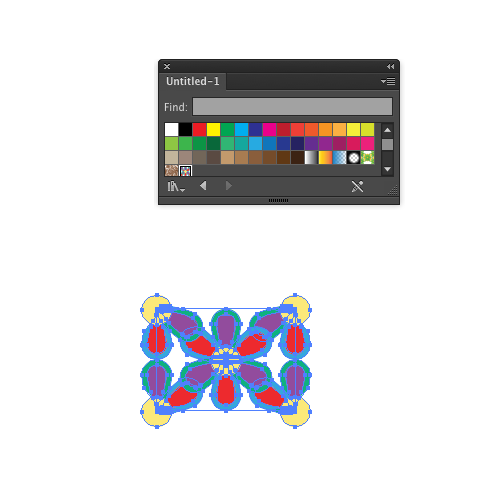
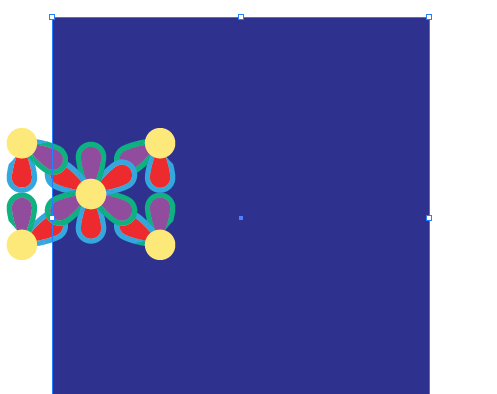
Copy link to clipboard
Copied
Wade, that is not what I mean.
I attach a link to one of many articles about creating seamless paterns in Illustrator previous versions
http://blog.spoongraphics.co.uk/tutorials/how-to-create-a-trendy-seamless-pattern-in-illustrator
by your example you have a tile, OK, but this is not good enough to send to printers or create a seamless pattern so as to print a wallpaper, or fabric, or wrapping paper, anything with repeat seamless pattern.The pattern will not repeat with an arbitrary backround attach- that background will still be there. To explain better- to make the Pattern maker swatch work for the purpose I would have to create the pattern with Pattern maker and then create an artboard of the size I want to print on- that would have to be say 10 meters by 1.5 meters for example! That would not be possible to contain in a managable file! The printer of such goods take a one tile file which flows seamlessly to create a pattern of desirable size. I am looking to find out how to export this seamless file that Pattern Maker promises to create in its form- with all the elements overlapping as the shoud when they are output to a bigger size. Does this make sense?
I tried to create an artboard of precise dimensions to the one I created the pattern in, that fill that with my pattern precisely but unfortunately that does not seem to workeither!
Copy link to clipboard
Copied
The tile I am showing you is the same as a seamless tile made in any previous version as far as I know there is not difference it has the no fill no stroke rectangle defining the tile.
If you are saying you need the art actually trimmed that is easy enought to do.
I do not really see the problem do as you yourself suggest drag the swatch to the canvas turn on smart guide select the tile rectangle copy paste inf front
Object>Artboard Convert to Artboard as as an AI file but select to export artboards and select a range and select the artboard
Or copy and paste in front Object>Path>Devide Objects below and delete the extra parts.
I don't see the problem
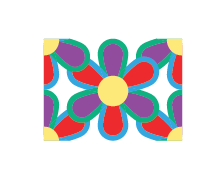
Copy link to clipboard
Copied
And it has a transparent background as before
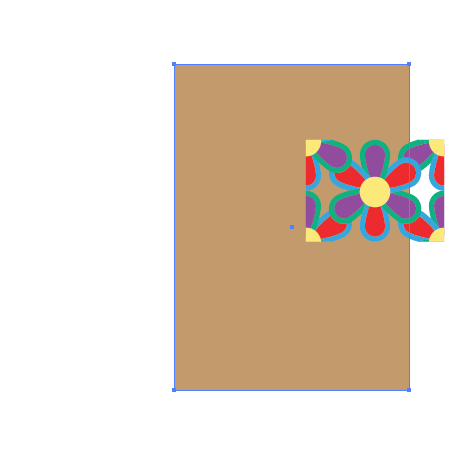
Copy link to clipboard
Copied
Hi Wade! That's it I think! The trick is to delete those extra items and be left only with the tile that Pattern Maker creates because when you drag the swatch you have all these extra items around the tile.
However, I was unable to recreate that, could you please instruct me with the steps how to get rid of those items again. There is something I am not doing right. .
many thanks!
Copy link to clipboard
Copied
I'll do a little video.
I understand now that you do not actually want a format as such but just a clean way of getting the srt as a baic tile without having to match upp everything manually and this can much more easily be done withthe new pattern tool.
And actually you answered your own question you'll see what I msean when I do the video.
Copy link to clipboard
Copied
kociara,
You are misinterpreting the intent of the feature. It's not a utility for exporting some kind of special seamless tile format to external vertical-market, industry-specific production applications. It's just an enhancement of the age-old Pattern Swatch feature of Illustrator, intended for use in Illustrator artwork. After being used, the result is just ordinary Illustrator artwork like any other. It can be exported in the same ways that any other ordinary Illustrator artwork can be exported, with the same caveats and limitations of the chosen export format.
If you have an external application that can, for example, import .ai or .eps or .pdf as a vector graphic or can import a PNG with alpha transparency, then flop and replicate that graphic to make a seamlessly repeating pattern, then you can do that just like you could prior to this feature. But it's not meant to be a "format" that is exported to some other program and understood by that other other program as a tiling command. It's just a drawing feature inside Illustrator. It's just a tiling command inside Illustrator.
...but can it be of any use for textile design?
By way of analogy, consider the fact that Illustrator artwork is quite commonly delivered to embroidery shops for use in imprinting garments. But that doesn't mean that the Illustrator file contains anything specific to the embroidery industry's workflow, software or equipment. The Illustrator file doesn't include any commands to fill a path with stitches. What's delivered is just ordinary Illustrator artwork. The embroidery shop may ro may not be able to import the Illustrator paths into an embroidery application which then fills them with stitch commands.
By the same token, exporting the artwork paths contained in an Illustrator Pattern (whether old or new) just yields normal AI paths. It doesn't export tiling commands to be understood by some other program.
JET
Copy link to clipboard
Copied
Hi JET
Thank you for the reply. However this does not answer my question. I am fully aware that Illustrator is not textile induxtry specific software ( there are such softwares out there, some of them extremely pricey) but Illustrator ( as well as Photoshop) have been widely used to create seamless tiles for repeat patterns in the textile industry, wallpaper, wrapping paper printing and such like. There is a work around process to create seamless tiles in previous Illustrator versions as well as Photoshop.
My question was about the fact that the new Pattern feature would have been amazing if creating such tile was easily possible. After all the process of creating seamless tile has been much improved in creating the elements needed for overlap automatically so why not go just a step further and be able to actually output the ready made tile with all the overlapping items in the right position?
I am hoping Wade above has solved the problem of extracting such file after all! The tiling command is irrelevant for external applications as long as the elemnts in the tile are positioned in the correct overlap position ( which the Pattern maker seems to be able to create) than the repeat is done automatically by the print provider, the crux of the matter is having that tile!
Copy link to clipboard
Copied
After all the process of creating seamless tile has been much improved in creating the elements needed for overlap automatically so why not go just a step further and be able to actually output the ready made tile with all the overlapping items in the right position?
Because the importing program would have to somehow suddenly understand that "overlapping." So you are left with what you had before this change to Illustrator's Patter Swatches: You have trim away the outboard portions of the actual repeating tile.
JET
Copy link to clipboard
Copied
what do you mean 'you have trim away' Is there such an option? That would be enough to do the trick!
The improvement of having this Pattern maker is massive from repeat pattern design point of view- the overlapping elements are created automatically and you have a preview of a larger scale pattern while designing seeing what the repeat will look like on the go. What is needed is easy one click trim away feature indeed.
Copy link to clipboard
Copied
Here is a video I see that you actually expect for this to be an automatic process it is not but on the other had it does not take very long to accomplish.
Copy link to clipboard
Copied
Hi Wade,
Thank you so much for the video, very helpful! I fear though that this will not work after all especially on complex patterns... One one of the patters I tried this on- the green one from default pattern swatches, after divinding, some parts of the objects would delete as well as the excess paths, not sure why.
Also it is not going to work on objects with strokes as the objects after dividding auto fill with stroke.
And then finally, rather annoyingly when I tried to afterwards to fit the artboard to the trimmed tile it has left about 1mm blank space on two sides ( the artboard will need to be fitted precisely so that the tile repats seamlessly)..
Hmmm, I think I may well need to forget about this Pattern making feature, does not look like it is going to be of any use to me... I will have some time tomorrow to experiment more and thank you again for your time and help!
Copy link to clipboard
Copied
Don't be surprise if you meet someone in your industry and in your conversation you tell them your tried Illustrator and it did not work and the respond back hey we use it all the time and it save us a lot of time.
I have a feeling thyis will be the case.
Copy link to clipboard
Copied
hope you are right! so far there is absoluetly nothing on that subject on the internet exept for tutorials how easy it is to create the patternin CS6 but only for use in Illustrator artwork... In any case will try and have a play with it tomorrow and see if it gets me anywhere. I will also try the solution from the web forum about it, they ended up creating a clipping mask
Copy link to clipboard
Copied
then just select the tile path and make certain it is on top and then select all and command or control 7 that should do it as well.
If masked srt will work that is easy as pie.
Here it is clipped

here it is with four tiles piece together manually as viewed in Acrobat if i can do this manually then the softwaare ashould be able to stitch it without a hitch. Otherwise your software is nothing.
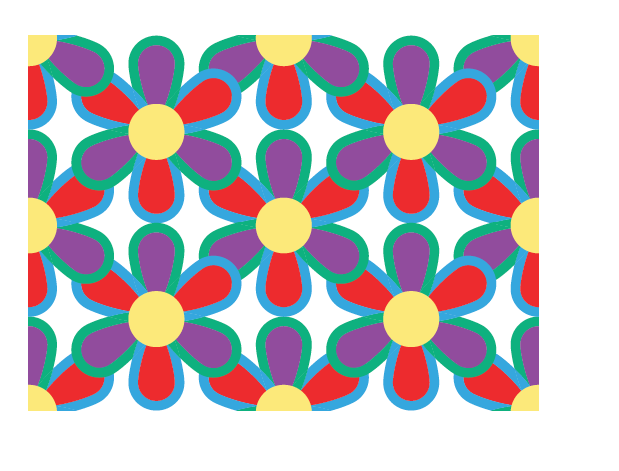
Copy link to clipboard
Copied
hi Wade,
I played around with it over the last two days and it can work on simple patterns, with more complex ones it's a bit of a pain deleting all the paths, fitting the artboard and seeing more need deleting as small gaps appear around the edge. Moreover, this does not work on strokes- if an object with a stroke is on the overlapping edge than after using Path- divide objects below command the stroke will be automatically filled and thus not produce the seamless result.
the tile needs to be absolutely seamless, and the fact that you can piece it manually in a different program does not help. I need to send to printers a seamless file wihich means that it fills the artboard accuratelly with no white gaps on the edges- otherwise the gaps will be reproduced as well and it will be clear where the tile finishes and where it ends
On a positive note it seems to work quite smoothly when you use the basic grid option ( rather than brick repeats etc)- then it seems to be enough to create an artboard of precisely the same size like the pattern tile and fill the tile with the pattern- so as long as the grid is used for repeat all seems rather fine though I have not inspected results in actual print yet. Strangely though, when I output the file the repeat works with my printers software on ai file only, not eps
Copy link to clipboard
Copied
I think it can be even simpler to save the pattern tile only. No need to delete paths (that can indeed be tricky).
I created a new Web document. Dragged the pattern named Jive to the artboard.
This is a complex pattern. To see the rectangle that defines the pattern it's easier to go to Outline View.
Select all and Ungroup.
Select the rectangle.
Select the Artboard tool (zoom in enough to be able to only click the rectangle) and double click the selected rectangle.
Or go to Object/Artboards/Fit to Selected Art.
That's it! The artboard becomes the size of the rectangle.
Save the file or export it as an image.
regards,
Ton

Copy link to clipboard
Copied
Hi Ton,
This is great! Worked perfectly and quickly even on strokes!!!
Howver when I tried to export the file as an image or save as eps it still picks up the images around the artboard. Is there a way of saving just the artboard? Not a massive problem, as it works for me in ai format, but would be interested to know
Copy link to clipboard
Copied
Thanks, good to hear it worked for you.
When you export, or do a save for web, you get only the pattern tile.
When you save the artboard as .ai. it will have the other elements in the file (for use by Illustrator), but they are not shown when you place them in InDesign or when you open the .ai file in Photoshop.
Ton
Find more inspiration, events, and resources on the new Adobe Community
Explore Now